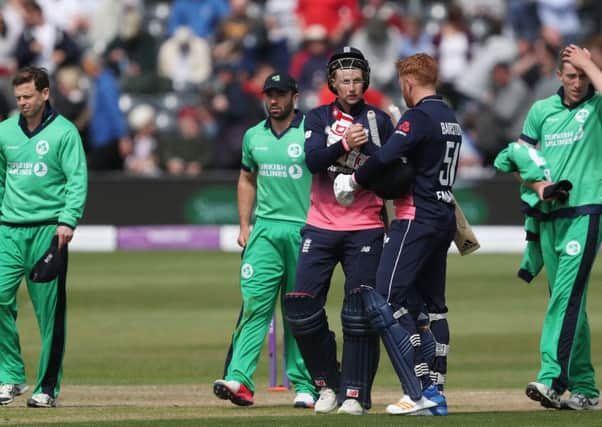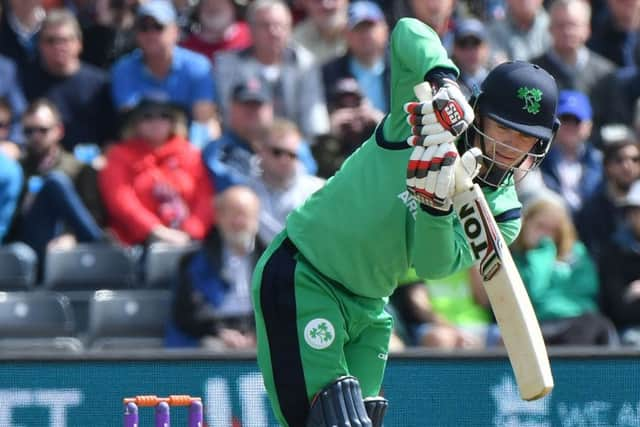Why Ireland are desperate to take part in the dying sport that is Test match cricket


West Indies, whose spectacular and saddening demise in the longer form of the game is a modern cricketing tragedy, pulled off one of the magnificent Test-match victories, overcoming a first-innings deficit of 81 to beat the tourists by 106 runs in Barbados.
There was only one problem, as Sky Television’s pictures showed, hardly anyone was there to watch it.
Advertisement
Hide AdAdvertisement
Hide AdThe Kensington Oval in Bridgetown, once one of the world’s most famous and iconic Test match grounds, should have been bursting at the seams and once upon a time it would have been. But there wasn’t even a smattering of spectators but instead row upon row of empty seats, a fact all the more poignant and bewildering as the momentum of a thrilling contest ebbed and flowed.


This was a ground that was once the very hub of Test match cricket in the Caribbean, all rum and raucous atmosphere, where a partisan but cheerful Barbados public roared on their heroes in the company of sunburnt tourists.
I should know. I watched successive Test matches there in 1998 and 1999, witnessing Mark Ramprakash’s long-awaited maiden Test hundred for England in March ‘98 and then, a year later, one of the all-time great Test matches when Steve Waugh’s Australian side were touring.
Waugh hit 199 as Australia built a towering first-innings lead, only for West Indies, inspired by fast-bowling greats Curtley Ambrose and Courtney Walsh, roared back to dismiss them for just 146 in the second.
Advertisement
Hide AdAdvertisement
Hide AdThere wasn’t a spare seat to be had on the final day as the great Brian Lara led West Indies to the most thrilling of one-wicket triumphs chasing an unlikely 308. It was the finest and most nerve-racking sporting contest I have ever witnessed as Lara (153 no), with number 11 Walsh for company, crashed the winning boundary.


Fast forward almost 20 years and Test match cricket in Barbados, and all around the Caribbean, is on its knees, and to think that this Thursday’s win over Pakistan is a turning point would be clutching at straws.
The demise is not just in the West Indies. The crowds in India, the unofficial world capital of the sport, for the Test series with Australia just a few weeks ago did little justice to some thrilling cricket.
So when Mike Atherton, former England captain and now the London Times cricket correspondent, asked Warren Deutrom, of Cricket Ireland during an interview this week why Irish cricket was so determined to dine at the Test match cricket table despite the game’s struggles, it was an entirely valid question.
Advertisement
Hide AdAdvertisement
Hide AdLast Friday’s confirmation that Ireland will almost certainly be granted Test match status later this summer is of course a landmark moment, one we could only have dreamt about even a decade ago.
But even the cricketing purists amongst us cannot deny that Test cricket, the most demanding form of the game, the ultimate test of a player’s technique and mental strength, is on the decline, its future shrouded in doubt.
Deutrom answered that Test cricket remains the ‘pinnacle’ for every cricketer. That is right, even if modern greats like Chris Gayle and AB de Villiers turning their backs on the format early might hint otherwise.
However, there is little doubt that someone like Ed Joyce is inspired to hang on in the game, hoping for the Test match cap that his glittering career deserves.
Advertisement
Hide AdAdvertisement
Hide AdBut, as Atherton wrote, acquiring full-member status is more about commercial potential and revenue than it is about prestige.
It will deliver the resources that will hopefully enable Irish cricket to develop domestically. Cricketers should be paid well enough that they will, in theory, be able to resist the lure of England, as Joyce, Boyd Rankin and Eoin Morgan understandably could not.
The indications are that Ireland will be eased into Test match cricket gently, and that is just as well, because as yesterday’s crushing ODI defeat to England and the Intercontinental Cup drubbing by Afghanistan demonstrated, they remain a team in transition.
Joyce, the O’Brien brothers and even captain William Porterfield are not the cricketers they once were and of the new brigade, perhaps only Andrew Balbirnie looks truly ready to follow in their footsteps.
Advertisement
Hide AdAdvertisement
Hide AdYou could argue though, and there are many who won’t like this, that the former Middlesex’s man development would be better served with a move back to the county game as opposed to staying in Ireland.
The financial windfall from full-member status will give Ireland financial muscle but while the interprovincial set-up here may be considered first-class in name, it will take some time for it to produce the skilled cricketers Ireland need to compete on the world stage.
There are other questions to be answered, about the viability of Test match cricket here, but for now securing the financial future has to be priority number one.